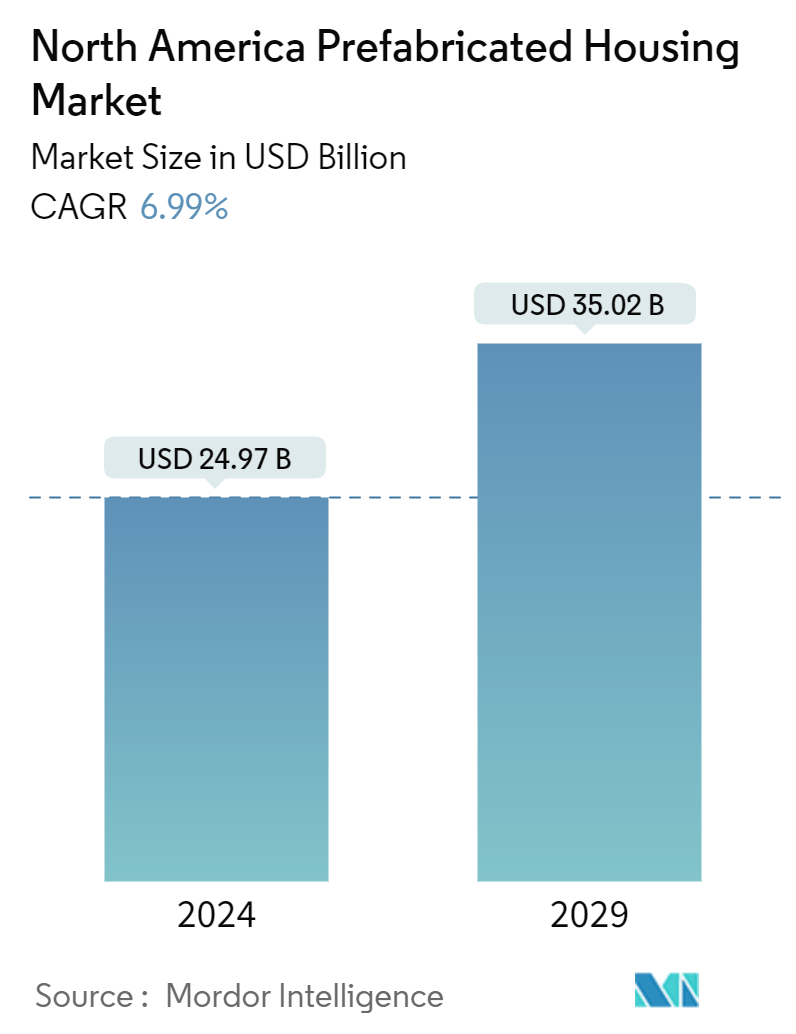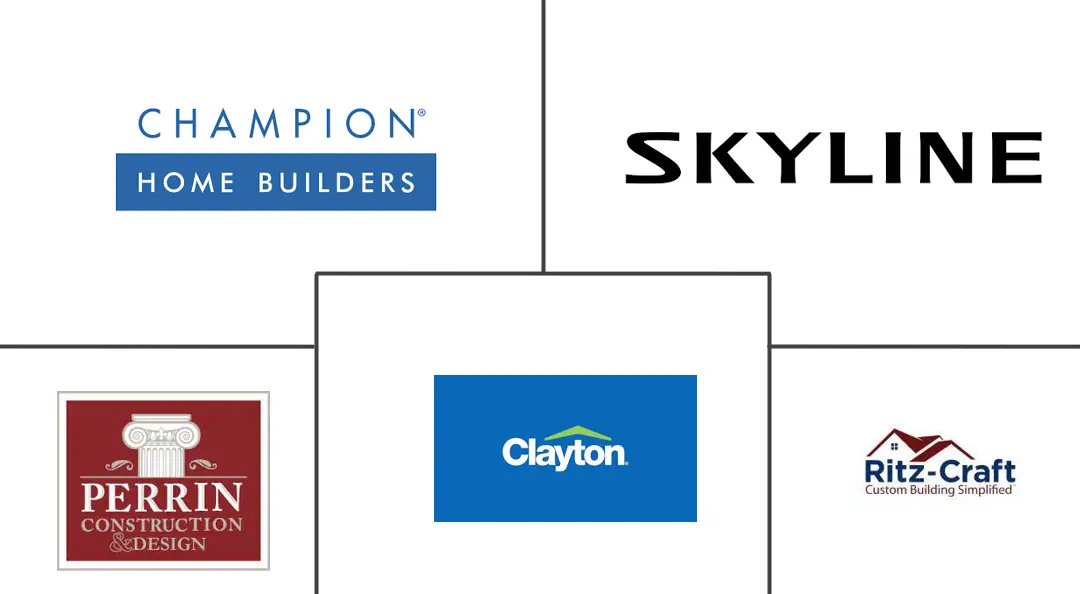Market Size of North America Prefabricated Housing Industry

| Study Period | 2020 - 2029 |
| Base Year For Estimation | 2023 |
| Market Size (2024) | USD 24.97 Billion |
| Market Size (2029) | USD 35.02 Billion |
| CAGR (2024 - 2029) | 6.99 % |
| Market Concentration | Low |
Major Players
*Disclaimer: Major Players sorted in no particular order |
North America Prefabricated Housing Market Analysis
The North America Prefabricated Housing Market size is estimated at USD 24.97 billion in 2024, and is expected to reach USD 35.02 billion by 2029, at a CAGR of 6.99% during the forecast period (2024-2029).
The North American market for prefabricated houses is experiencing significant growth, driven by the increasing demand for affordable and sustainable housing solutions. Modular construction, a major segment of prefabricated housing, is being widely adopted due to its cost-effectiveness and reduced construction time compared to traditional methods. Industry reports from November 2024 highlight that prefabrication can reduce project timelines by up to 50%, facilitating faster occupancy and substantial cost savings for developers.
Rising housing shortages across key regions in the United States and Canada have further propelled interest in prefabricated solutions. In 2023, the U.S. Census Bureau reported a year-over-year increase of over 7% in modular housing permits, particularly in areas struggling with housing affordability. This trend aligns with the sector’s capability to produce high-quality homes at a fraction of the traditional construction costs, effectively meeting the needs of a growing population.
Technological advancements in modular and prefabricated systems have enhanced design flexibility and energy efficiency, making them a preferred option for green building initiatives. According to industry associations, nearly 40% of new modular constructions in 2024 are integrating smart technologies and energy-saving features, reinforcing their appeal in both residential and commercial sectors.
North America Prefabricated Housing Industry Segmentation
Prefabricated homes, often referred to as "prefab homes," are primarily manufactured off-site and then delivered and assembled on-site.
The North American prefabricated housing market is segmented by type (single-family and multi-family) and country (the United States, Canada, and Mexico). The report offers market size and forecasts for the North American prefabricated housing market in value (USD billion).
| By Type | |
| Single-family | |
| Multi-family |
| By Country | |
| United States | |
| Canada | |
| Mexico |
North America Prefabricated Housing Market Size Summary
The North American prefabricated housing market is poised for significant growth, driven by the increasing demand for affordable and high-quality housing solutions. The market is characterized by a shift towards modular construction methods, which offer cost-effective and efficient alternatives to traditional building practices. This shift is further supported by the region's focus on green building initiatives and the need for quick construction solutions due to extreme weather conditions. The market's expansion is also fueled by the ongoing recovery in the construction sector post-COVID-19, with a particular emphasis on nonresidential and institutional projects. The rise in urbanization and the shortage of affordable housing in the United States present substantial opportunities for prefabricated housing manufacturers to meet the growing demand for single-family homes.
The market landscape is highly fragmented, with numerous manufacturers and service providers competing for market share. Key players such as Skyline Corporation, Champion Home Builders Inc., and Clayton Homes Inc. are actively contributing to the market's growth through innovative solutions and strategic partnerships. The integration of advanced technologies and eco-friendly materials in the construction of prefabricated homes is expected to enhance market appeal and drive further expansion. As cities continue to grow and investments in the construction sector increase, the prefabricated housing market in North America is anticipated to experience moderate to robust growth, offering ample opportunities for industry participants to capitalize on emerging trends and consumer preferences.
North America Prefabricated Housing Market Size - Table of Contents
-
1. MARKET DYNAMICS
-
1.1 Market Overview
-
1.2 Market Drivers
-
1.2.1 Faster Construction Times
-
1.2.2 Sustainability and Reduced Waste
-
-
1.3 Market Restraints
-
1.3.1 Regulatory and Zoning Challenges
-
1.3.2 Perception and Quality Concerns
-
-
1.4 Market Opportunities
-
1.4.1 Technological Advancements in Modular Designs
-
-
1.5 Value Chain / Supply Chain Analysis
-
1.6 Porters 5 Force Analysis
-
1.6.1 Threat of New Entrants
-
1.6.2 Bargaining Power of Buyers/Consumers
-
1.6.3 Bargaining Power of Suppliers
-
1.6.4 Threat of Substitute Products
-
1.6.5 Intensity of Competitive Rivalry
-
-
-
2. MARKET SEGMENTATION
-
2.1 By Type
-
2.1.1 Single-family
-
2.1.2 Multi-family
-
-
2.2 By Country
-
2.2.1 United States
-
2.2.2 Canada
-
2.2.3 Mexico
-
-
North America Prefabricated Housing Market Size FAQs
How big is the North America Prefabricated Housing Market?
The North America Prefabricated Housing Market size is expected to reach USD 24.97 billion in 2024 and grow at a CAGR of 6.99% to reach USD 35.02 billion by 2029.
What is the current North America Prefabricated Housing Market size?
In 2024, the North America Prefabricated Housing Market size is expected to reach USD 24.97 billion.

